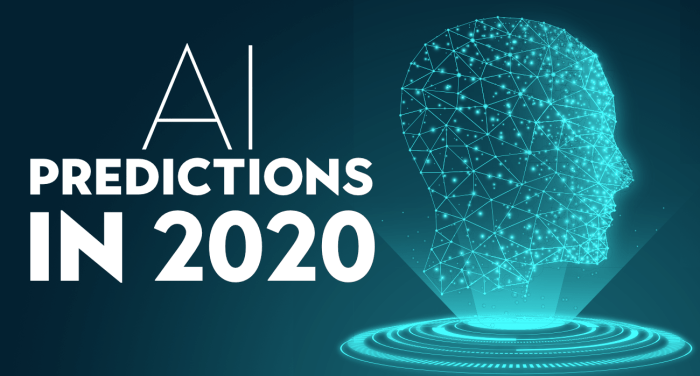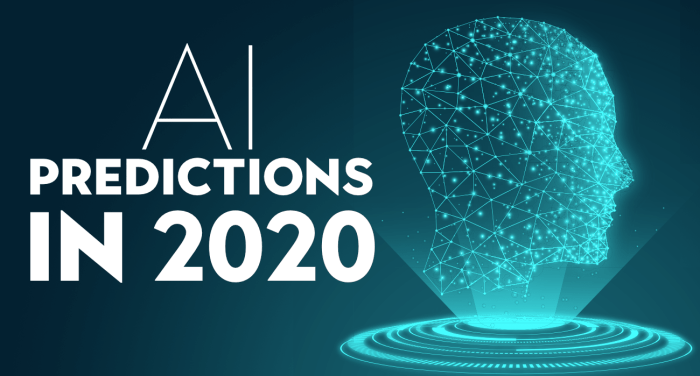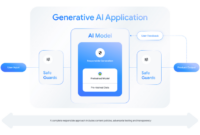Ai predictions * – AI predictions are revolutionizing the way we approach everything from healthcare to finance. This fascinating field is constantly evolving, with new advancements emerging all the time. From the early days of statistical models to the sophisticated deep learning techniques of today, AI predictions have come a long way.
This blog post explores the evolution of AI predictions, their diverse applications, and the key factors that influence their accuracy.
We’ll delve into the exciting potential of AI predictions, examining their impact on various industries and society as a whole. We’ll also discuss the ethical considerations surrounding AI predictions and explore the challenges and opportunities that lie ahead.
The Evolution of AI Predictions

AI prediction models have evolved significantly over the years, driven by advancements in computing power, data availability, and algorithmic sophistication. This journey has witnessed a shift from simple statistical methods to complex deep learning architectures, each contributing to the increasing accuracy and applicability of AI predictions in various domains.
Early Statistical Methods
Early AI prediction models relied heavily on statistical methods, such as linear regression and decision trees. These methods were relatively simple and interpretable, making them suitable for analyzing and predicting patterns in data.
- Linear Regression:This method establishes a linear relationship between a dependent variable and one or more independent variables, allowing for predictions based on the observed relationship. For instance, predicting house prices based on factors like location, size, and number of bedrooms.
- Decision Trees:This method constructs a tree-like structure where each node represents a decision based on a specific attribute, leading to a final prediction. For example, predicting loan approval based on credit score, income, and debt-to-income ratio.
These methods were effective for simpler prediction tasks but lacked the flexibility and capacity to handle complex, high-dimensional data.
The Rise of Neural Networks
The development of neural networks marked a significant breakthrough in AI prediction. These models, inspired by the structure and function of the human brain, are capable of learning complex patterns and relationships from data.
- Multilayer Perceptrons (MLPs):Early neural networks consisted of multiple layers of interconnected nodes, enabling the learning of non-linear relationships in data. These networks were used for tasks like image classification and handwritten digit recognition.
- Convolutional Neural Networks (CNNs):CNNs are specifically designed for image processing tasks, utilizing convolutional layers to extract features from images and make predictions. They have revolutionized fields like medical imaging, object detection, and autonomous driving.
- Recurrent Neural Networks (RNNs):RNNs are designed for sequential data, such as text or time series data. They possess internal memory, allowing them to consider previous inputs when making predictions. RNNs have found applications in natural language processing, machine translation, and financial forecasting.
Neural networks have significantly improved the accuracy and complexity of AI predictions, enabling the analysis of large datasets and the identification of intricate patterns.
Deep Learning and Beyond
The emergence of deep learning, a subfield of machine learning that utilizes deep neural networks, has further propelled AI prediction capabilities. Deep learning models are trained on massive datasets and are capable of learning highly complex representations of data, leading to unprecedented prediction accuracy.
- Deep Neural Networks (DNNs):These networks consist of multiple hidden layers, enabling the learning of highly complex representations of data. They have achieved state-of-the-art results in various tasks, including image recognition, natural language processing, and speech recognition.
- Generative Adversarial Networks (GANs):GANs are a type of deep learning model that consists of two competing neural networks, a generator and a discriminator. The generator creates synthetic data, while the discriminator attempts to distinguish between real and generated data. GANs have been used for image generation, data augmentation, and anomaly detection.
Discover more by delving into the cause of lithium ion battery fires ebikes escooters new york further.
- Reinforcement Learning (RL):RL is a type of machine learning where an agent learns through trial and error by interacting with its environment. RL models have been used to develop AI systems that can play games, control robots, and optimize complex systems.
Deep learning has revolutionized AI prediction, enabling the development of sophisticated models that can tackle increasingly complex tasks and achieve unprecedented accuracy.
Applications of AI Predictions: Ai Predictions *
AI predictions are no longer a futuristic concept; they are transforming various industries, offering valuable insights and driving better decision-making. From healthcare to finance, transportation to marketing, AI predictions are making a tangible impact, optimizing processes, and improving outcomes.
AI Predictions in Healthcare
AI predictions are revolutionizing healthcare by enabling more accurate diagnoses, personalized treatments, and proactive disease management.
- Predicting Patient Outcomes:AI algorithms can analyze patient data, including medical history, lab results, and lifestyle factors, to predict the likelihood of developing certain diseases or the success rate of specific treatments. This information helps doctors make informed decisions about patient care and personalize treatment plans.
- Early Disease Detection:AI-powered tools can analyze medical images, such as X-rays and MRIs, to identify early signs of diseases like cancer, allowing for timely interventions and potentially improving treatment outcomes.
- Drug Discovery and Development:AI can accelerate drug discovery by analyzing vast datasets of chemical compounds and identifying potential drug candidates, reducing the time and cost associated with traditional methods.
However, ethical considerations are paramount in healthcare. AI predictions must be transparent, explainable, and unbiased to avoid perpetuating existing health disparities and ensuring equitable access to care.
AI Predictions in Finance
AI predictions are playing a crucial role in finance, empowering financial institutions to make better investment decisions, manage risk more effectively, and detect fraudulent activities.
- Predictive Analytics for Investment:AI algorithms can analyze market trends, economic indicators, and company performance data to predict stock prices, identify investment opportunities, and manage portfolio risk.
- Fraud Detection:AI can detect fraudulent transactions by analyzing patterns in financial data and identifying anomalies that may indicate suspicious activity. This helps banks and other financial institutions prevent financial losses and protect their customers.
- Credit Risk Assessment:AI models can analyze a borrower’s financial history, credit score, and other relevant data to assess their creditworthiness and predict the likelihood of loan defaults. This enables lenders to make more informed lending decisions and manage their portfolio risk.
It is essential to address ethical concerns regarding the use of AI predictions in finance, particularly in areas like credit scoring, where biased algorithms could lead to unfair outcomes for certain individuals or groups.
AI Predictions in Transportation
AI predictions are transforming the transportation industry by optimizing traffic flow, enhancing safety, and improving efficiency.
- Traffic Management:AI algorithms can analyze real-time traffic data, weather conditions, and other factors to predict traffic congestion and optimize traffic flow by adjusting signal timing and providing alternative routes to drivers.
- Autonomous Vehicles:AI-powered self-driving cars rely on advanced prediction algorithms to navigate complex environments, anticipate potential hazards, and make safe driving decisions. This technology holds the potential to revolutionize transportation, reduce accidents, and improve efficiency.
- Predictive Maintenance:AI can analyze sensor data from vehicles to predict potential failures and schedule maintenance proactively, reducing downtime and improving overall vehicle reliability.
The development and deployment of AI predictions in transportation must prioritize safety and ethical considerations, addressing concerns about data privacy and potential biases in algorithms.
AI Predictions in Marketing
AI predictions are empowering marketers to understand customer behavior, personalize marketing campaigns, and optimize marketing spend.
- Customer Segmentation:AI algorithms can analyze customer data, including demographics, purchase history, and website interactions, to identify different customer segments with distinct needs and preferences. This allows marketers to tailor their messages and offers to specific customer groups.
- Predictive Analytics for Marketing:AI can predict customer behavior, such as purchase likelihood, churn risk, and response to marketing campaigns. This information enables marketers to optimize their campaigns, target the right customers, and maximize their return on investment.
- Personalized Recommendations:AI-powered recommendation engines analyze user data and preferences to provide personalized product recommendations, enhancing customer experience and driving sales.
Ethical considerations in AI-driven marketing include ensuring data privacy, avoiding discriminatory targeting, and maintaining transparency in how algorithms are used to influence customer behavior.
Key Factors Influencing AI Predictions
AI predictions, powered by machine learning algorithms, are transforming various industries. However, the accuracy and reliability of these predictions depend heavily on several key factors. Understanding these factors is crucial for building effective and trustworthy AI systems.
Data Quality and Quantity
The quality and quantity of data used to train AI prediction models are fundamental to their accuracy. High-quality data, free from errors, inconsistencies, and biases, is essential for building robust models.
- Data Quality:Clean and accurate data is paramount. Errors or inconsistencies can lead to inaccurate predictions. For instance, a model predicting customer churn might be inaccurate if the data contains incomplete or incorrect customer information.
- Data Quantity:The more data a model is trained on, the better it can learn patterns and make accurate predictions. For example, a model predicting house prices would require a large dataset of historical sales data to learn the complex relationships between factors like location, size, and market trends.
Feature Engineering and Model Selection
Feature engineering, the process of selecting and transforming relevant data features, plays a crucial role in optimizing AI predictions. Model selection involves choosing the appropriate algorithm for the specific prediction task.
- Feature Engineering:Selecting the right features and transforming them effectively can significantly improve model performance. For example, instead of using raw data like customer age, a model might benefit from using engineered features like age groups or customer lifetime value.
- Model Selection:Different machine learning algorithms excel in different scenarios. Choosing the right algorithm for the task at hand is crucial. For example, a linear regression model might be suitable for predicting house prices, while a deep learning model might be better for image classification tasks.
Bias and Fairness
AI models can inherit biases from the data they are trained on, leading to unfair predictions. Addressing bias is essential for ensuring ethical and responsible AI applications.
- Bias in Data:If training data reflects societal biases, the model will likely learn and perpetuate these biases. For example, a model trained on historical loan applications might perpetuate existing biases against certain demographic groups.
- Mitigation Strategies:Strategies to mitigate bias include:
- Data Augmentation:Adding data to the training set to represent underrepresented groups can help reduce bias.
- Fairness Metrics:Using fairness metrics to evaluate model performance across different groups can help identify and address bias.
- Bias Detection and Mitigation Techniques:Advanced techniques like adversarial training and fairness-aware learning can be used to mitigate bias during model training.
The Future of AI Predictions
The realm of AI predictions is rapidly evolving, with groundbreaking advancements in technology and applications. The future holds immense potential for AI predictions to transform various industries and aspects of society. This section explores emerging trends, potential impacts, and challenges and opportunities for future development.
Explainable AI and Reinforcement Learning
Explainable AI (XAI) and reinforcement learning (RL) are two crucial trends shaping the future of AI predictions. XAI focuses on making AI models more transparent and understandable, allowing users to comprehend the reasoning behind predictions. This is particularly important in fields like healthcare, finance, and law, where decisions based on AI predictions need to be transparent and justifiable.
RL, on the other hand, involves training AI models through trial and error, allowing them to learn and adapt over time. This approach is proving effective in areas like robotics, gaming, and autonomous vehicles, where AI models need to navigate complex and dynamic environments.
“Explainable AI (XAI) aims to make AI models more transparent and understandable, allowing users to comprehend the reasoning behind predictions.”
Impact on Industries and Society
AI predictions are poised to revolutionize numerous industries and aspects of society.
- In healthcare, AI predictions can assist in early disease detection, personalized treatment plans, and drug discovery.
- In finance, AI predictions can improve risk assessment, fraud detection, and investment strategies.
- In transportation, AI predictions can optimize traffic flow, enhance safety, and enable autonomous driving.
- In education, AI predictions can personalize learning experiences and identify students who might need additional support.
Beyond individual industries, AI predictions have the potential to address global challenges like climate change, poverty, and inequality. By analyzing vast amounts of data, AI models can identify patterns and trends that humans might miss, enabling more informed decision-making and effective solutions.
Challenges and Opportunities, Ai predictions *
While the future of AI predictions holds great promise, several challenges need to be addressed to ensure responsible and ethical development and deployment.
- One major challenge is ensuring the accuracy and reliability of AI predictions.
- Another challenge is mitigating bias in AI models, which can arise from the data they are trained on.
- Furthermore, there are concerns about the potential impact of AI predictions on employment and privacy.
Despite these challenges, the opportunities for further research and development in AI predictions are vast.
- One area of focus is developing more robust and reliable AI algorithms.
- Another area is exploring new applications of AI predictions in emerging fields like quantum computing and synthetic biology.
- Finally, there is a need for increased collaboration between researchers, policymakers, and industry leaders to ensure the ethical and responsible development and deployment of AI predictions.





